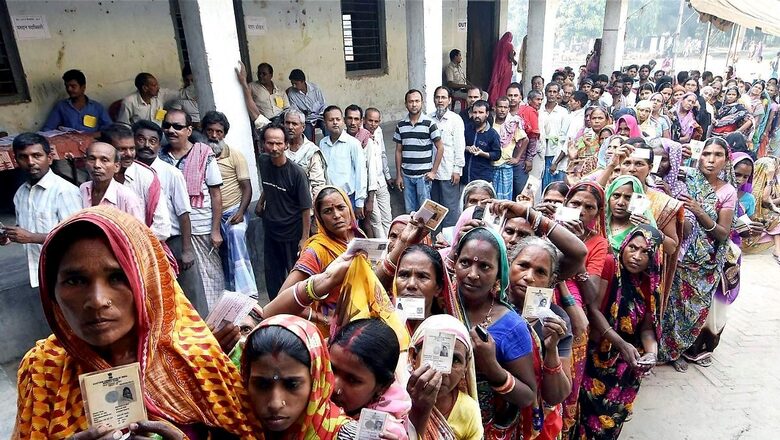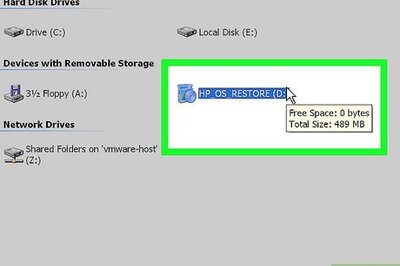
views
The Narendra Modi-led BJP government has constituted a committee headed by former president Ram Nath Kovind over “One Nation, One Polls". The development comes amid the government calling a special session of Parliament between September 18 and 22, the agenda for which is not known.
Currently, the Election Commission (EC) conducts the elections for state assemblies and Lok Sabha (Parliament) as separate events. Every state holds its elections every five years, similar to the Lok Sabha, however, most of the state have their own electoral cycle. Some states namely, Andhra Pradesh, Arunachal Pradesh, Odisha and Sikkim held elections with the Lok Sabha polls in 2019.
What is One Nation, One Election
The idea of ‘One Nation, One Election’ refers to holding simultaneous elections across the country, which means, that the polls for Lok Sabha and state assemblies will be held together.
The committee’s formation over ‘One Nation, One Election’ comes at a time when five states- including Madhya Pradesh and Rajasthan are bracing for assembly elections in November-December. The assembly elections will precede the Lok Sabha elections, expected in May-June 2024. Andhra Pradesh, Odisha, Sikkim and Arunachal Pradesh assemblies are scheduled to go to the polls with the Lok Sabha elections.
The government’s move suggests that it might be contemplating advancing some of these elections to coincide with the Lok Sabha polls. Kovind will explore the feasibility of the exercise and the mechanism to see as to how the country can go back to having simultaneous Lok Sabha and state assembly polls.
Where Did the Idea Come from
The idea of ‘One Nation, One Polls’ was proposed in the 1980s where the Election Commission suggested in 1983 that a system should be evolved so that elections to Lok Sabha and state legislative Assemblies could be held simultaneously.
The Justice B P Jeevan Reddy-headed Law Commission said in its 170th Report in May 1999 that “we must go back to the situation where the elections to Lok Sabha and all the Legislative Assemblies are held at once".
However, the official discussion on the idea began under the BJP government. In a 2015 report titled ‘Feasibility of Holding Simultaneous Elections to the House of People and State Legislative Assemblies’, the Parliamentary Standing Committee on Personnel, Public Grievances, Law and Justice recommended “an alternative and practicable method of holding simultaneous elections. The idea involved holding elections in two phases, halfway into the term of Lok Sabha and at the end of the Lok Sabha term for the rest.
In June 2019, the government had invited 40 political parties to discuss ‘one nation, one election’. After the meeting, Defence minister Rajnath Singh stated that only 21 parties attended and three other parties sent their views.
In 2022, the then Chief Election Commissioner Sushil Chandra said the EC is fully prepared and capable of conducting simultaneous elections. In December the same year, the Law Commission sought the opinion of stakeholders including political parties, the EC, bureaucrats, academicians and experts on the proposal to hold simultaneous elections in the country.
How Does it Help?
The elections for the Lok Sabha and the state assemblies were held simultaneously in 1951-52, 1957, 1962 and 1967. However, the cycle of state assemblies was disrupted due to premature dissolution of assemblies. The Lok Sabha was also dissolved early in 1970.
Experts have suggested that the idea will cut costs of conducting elections separately in the states. In 2018, the Law Commission in a report said that simultaneous elections would yield several benefits, including, cost savings, alleviation of strain on administration and security forces, enhanced efficacy in the implementation of policies, and the ability to remain focused on developmental efforts.
In 2019 Lok Sabha elections, a sum of Rs 60,000 crore was spent on the elections including the amount spent by political parties fighting the polls and the spending of EC to hold elections. The 2009 Lok Sabha elections had cost the exchequer about Rs 1,115 crore, and the 2014 elections, about Rs 3,870 crore, according to a NITI Aayog report.
However, the actual money spent on the elections, including the expenditure of the parties and candidates, was several times more. The EC has estimated the cost of holding simultaneous elections to Lok Sabha and state Assemblies at Rs 4,500 crore, according to a report in The Indian Express.
There are other benefits of the move like increasing voter percentage, lesser corruption and saving time and energy.
What Has PM Modi Said on Simultaneous Elections?
PM Modi has been an ardent supporter of unifying the electoral cycles for both the Lok Sabha and state assemblies. In November, 2020, he raised the pitch for “One Nation, One Election" by saying that it is the need of the country. “Elections are held at different places every few months and it hampers the developmental work and all of you know about it," he said.
In January 2022, he raised the issue of “one nation, one election" again on National Voters’ Day saying that the continuous cycle of election results in politics being seen in everything while development suffers.
The government’s latest decision to nominate Kovind to spearhead the exploratory committee is seen as a confirmation of the government’s earnestness to bring this concept to fruition.
The BJP has always been supporting the idea of simultaneous elections. The party’s manifesto for the 2014 Lok Sabha polls said, “Evolve method of holding Assembly and Lok Sabha elections simultaneously."
Who are Opposing?
Many opposition parties including the Aam Aadmi Party, Shiv Sena (UBT) and others have opposed it. AAP, earlier in January, alleged that the BJP was proposing simultaneous elections to replace the parliamentary form of government with a presidential system.
Shiv Sena (UBT) leader Sanjay Raut opposing the proposal said, “The country is already one, is anyone questioning that? We demand fair election, not ‘one nation one election’. This funda of ‘one nation one election’ is being brought to divert the attention from our demand of fair election."
While some Congress leaders like Bhai Jagtap have called for more discussion on the issue, others like Chhattisgarh Deputy Chief Minister TS Singh Deo said he was in favour of the idea.
Arguments Against the Idea
In order to hold simultaneous elections, a constitutional amendment will be needed. Some critics have said that amending the constitution for simultaneous elections would fundamentally alter its democratic and federal character.
India is a ‘Union of States’ and the states have their own directly elected governments. Therefore, fixing a term adversely affects this right. There are the logistics including the deployment of security forces and officials in 700,000 polling stations located across geographic and climatic conditions.
A study conducted by the IDFC Institute further suggested that there is a 77 percent chance that voters will choose the same winning party or alliance in the state assembly and the Lok Sabha if there are simultaneous elections. While,




















Comments
0 comment